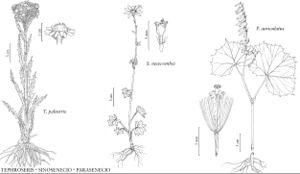Tephroseris
Deut. Bot. Herb.-Buch, 87. 1841.
| Taxon | Illustrator ⠉ | |
|---|---|---|
 | Tephroseris palustris Sinosenecio newcombei Parasenecio auriculatus | Yevonn Wilson-Ramsey Yevonn Wilson-Ramsey Yevonn Wilson-Ramsey |
Annuals, biennials, or perennials, (5–) 10–100+ cm (rhizomatous or caudices ± erect; plants usually arachnose, floccose, lanate, tomentose, or villous, sometimes unevenly glabrate). Stems 1 or more (loosely clustered), erect. Leaves basal and cauline; alternate; petiolate (basal and proximal cauline; distal leaves usually sessile, smaller, bractlike); blades pinnately nerved, lanceolate, linear-oblanceolate, oblanceolate, ovate, or subrhombic (bases tapering or contracted to petioles), margins entire or dentate, denticulate, subentire, subpinnatifid, or wavy, faces usually arachnose, floccose, lanate, tomentose, or villous, sometimes unevenly glabrate. Heads radiate or discoid, borne singly or (2–40+) in corymbiform arrays. Calyculi 0. Involucres hemispheric or campanulate to turbinate, 8–12+ mm diam. Phyllaries persistent, usually 8, 13, or 21 in (1–) 2 series, erect, distinct (margins interlocking), lance-linear to lanceolate or oblong, equal, margins ± scarious (abaxial faces usually arachnose, floccose, lanate, tomentose, or villous, sometimes unevenly glabrate). Receptacles flat or ± dome-shaped (not conic), smooth, epaleate. Ray-florets 0 or mostly 8, 13, or 21, pistillate, fertile; corollas usually yellow, orange, or orange-yellow, sometimes ochroleucous or white [brick-colored, purplish] (laminae usually 5–20 mm, sometimes 1–3 mm). Disc-florets 30–80+, bisexual, fertile; corollas usually yellow, orange, or orange-yellow, sometimes ochroleucous or white [brick-colored, purplish], tubes longer than or equaling campanulate throats, lobes 5, erect or recurved, lance-linear (anther collars cylindric); style-branches: stigmatic areas continuous, apices rounded-truncate. Cypselae ± cylindric, 10-ribbed or nerved, glabrous or puberulent; pappi persistent, of 30–60+, white, whitish, or brownish, barbellulate bristles (equaling or slightly exceeding involucres, sometimes exceeding involucres to 10 mm in T. palustris). x = 24.
Distribution
n North America, centered in n Eurasia
Discussion
Species 40–50 (6 in the flora).
Species of Tephroseris are variable and poorly defined; their nomenclature is complex. The present treatment is provisional.
Tephroseris has been treated within Senecio in most North American floristic studies (T. M. Barkley 1999). Moreover, the tradition has been to treat much of the variation as varieties or subspecies within a broadly circumscribed Senecio (Tephroseris) atropurpureus (e.g., Barkley 1978; E. Hultén 1968; H. J. Scoggan 1978–1979, part 4; S. L. Welsh 1974); current thought is to recognize more species and thereby bring North American species concepts more into accord with those of Russian botanists (e.g., S. S. Kharkevich 1992, vol. 6; I. M. Krasnoborov 1997, vol. 13; E. Wiebe 2000). The circumscription of Tephroseris was discussed by B. Nordenstam (1978).
The Eurasian Tephroseris atropurpureus (Ledebour) B. Fedtschenko, in the strict sense, and T. subfrigida (Komarov) Holub may occur in far western Alaska. The former resembles T. frigida; it has smaller heads, narrower, purplish phyllaries, and a different “aspect.” Tephroseris subfrigida is a relatively tall, thin plant with phyllaries purplish on the distal one-third; the bases of the heads have a light yellowish, non-woolly tomentum.
Selected References
Lower Taxa
Key
| 1 | Annuals or biennials (rarely perennials; caudices fibrous-rooted); leaves basal and cauline (basal and proximal sometimes withering before flowering, mid-stem leaves prominent at flowering); heads (4–)6–20(–40+) | Tephroseris palustris |
| 1 | Perennials (rhizomes spreading, sometimes suberect); leaves basal and cauline (basal and proximal cauline usually evident at flowering; distal cauline smaller, bractlike); heads 1–4(–6+) | > 2 |
| 2 | Basal and proximal leaves: margins usually irregularly toothed; phyllaries brown-woolly | Tephroseris kjellmanii |
| 2 | Basal and proximal leaves: margins subentire or denticulate (if shallowly toothed, phyllaries yellow-hairy at bases); phyllaries ± villous or floccose- or lanate-tomentose (hairs yellow, white, or purplish), sometimes glabrate | > 3 |
| 3 | Phyllaries floccose-tomentose (hairs yellow) | Tephroseris yukonensis |
| 3 | Phyllaries ± villous or floccose- or lanate-tomentose (hairs white or purplish), sometimes glabrate | > 4 |
| 4 | Involucres tapering to peduncles; phyllaries (and distal herbage) ± villous (at least some hairs purplish or with purplish cross-walls) | Tephroseris frigida |
| 4 | Involucres ± abruptly contracted to peduncles; phyllaries floccose- or lanate-tomentose (hairs white) to unevenly glabrate | > 5 |
| 5 | Phyllaries purple (at least distal 1/3); corollas orange or orange-yellow; laminae of ray corollas usually 15–25 mm | Tephroseris lindstroemii |
| 5 | Phyllaries greenish (tips sometimes purplish); corollas yellow; laminae of ray corollas (8–)10–15 mm | Tephroseris tundricola |